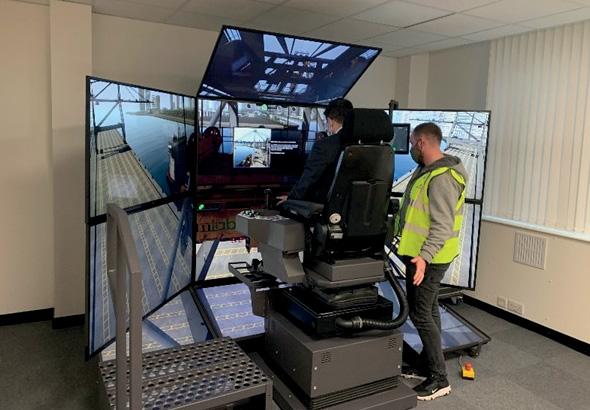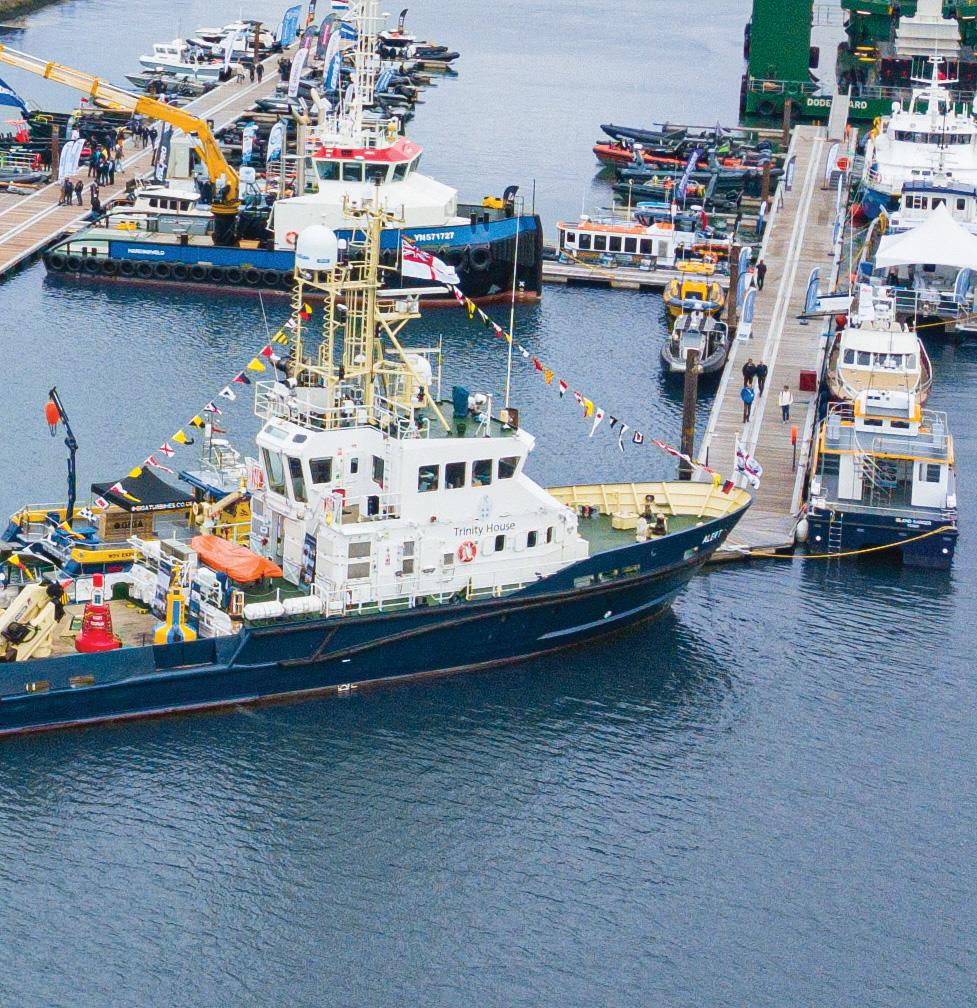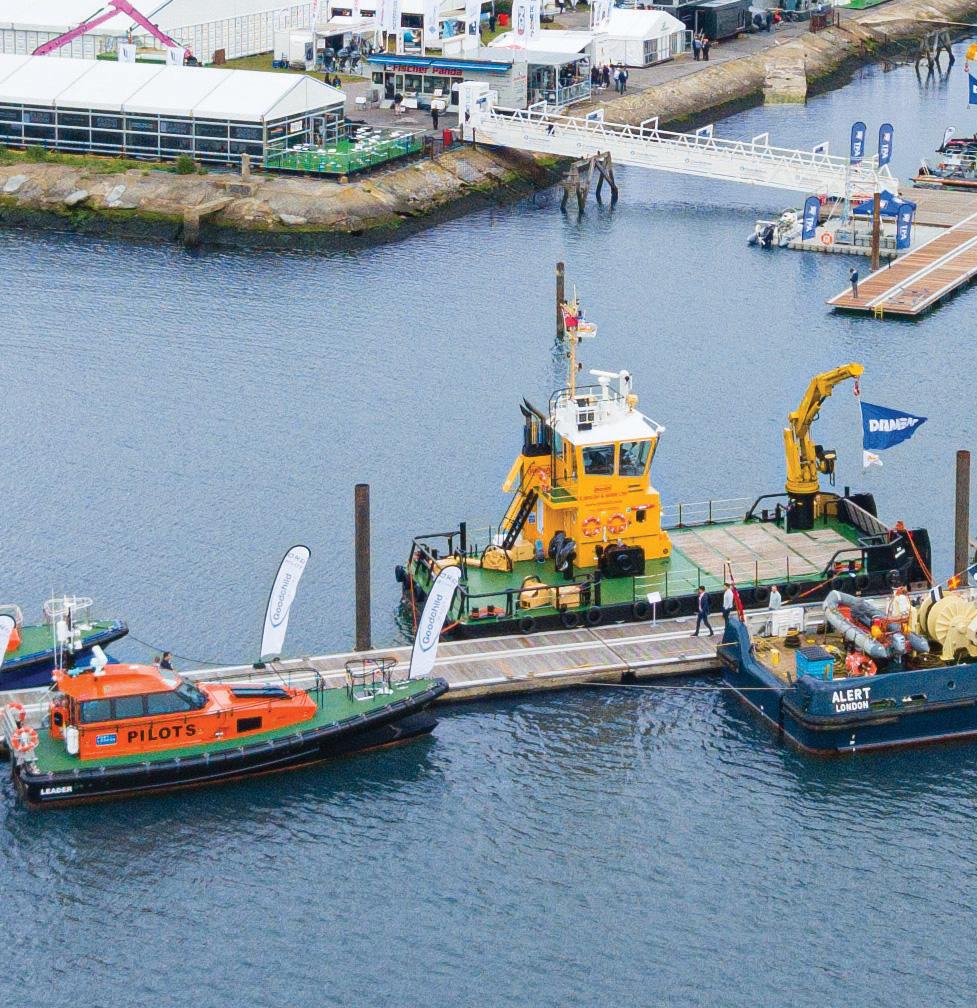
12 minute read
Port Sim
QUICK TURNAROUND FOR SAFETY CRITICAL PORT SIMULATOR
French simulation specialist company ST Engineering Antycip has delivered its largest ever port simulation system to The Bristol Port Company
The new equipment, including full training, was delivered in the space of only six weeks, despite diffi culties created by the pandemic.
The company also helped to specify a room to accommodate the 10-screen simulator in The Bristol Port Company’s newly renovated training centre, which includes an instructor operator station to help with remote access and control of the main simulator functions and scenarios.
Amir Khosh, commercial and project manager at ST Engineering Antycip, was on-site to oversee the installation and head up the subsequent training.
“The Bristol Port Company is a major port in the UK, and in order to boost safety and productivity on site they required this state-of-the-art training device which will help shape future training and industry standards,” he said.
Using simulators for operator training gives another dimension to the training conducted at the port, allowing operators with diverse skill sets and backgrounds to conduct progressive training in a safe and risk-free environment.
“This strategic win will help ST Engineering Antycip engage in more commercial applications in the Port industry,” said Khosh. “Together with CM Labs, we will be supporting The Bristol Port Company in achieving great results with their newest training tool.”
He added: “It was very challenging process but with great team effort and collaboration, we managed to commission the simulator, train the team effectively, and efficiently get them operational as soon as possible.”
Nick Venn, training manager at The Bristol Port Company, originally approached ST Engineering Antycip in 2019 in the hopes of finding an effective approach to take his teams’ training to the next level.
“We’re very happy with our results thus far,” Venn said. “We have introduced several candidates to the Ship-to-Shore simulator module with great success. The training instructors have embraced this new technology in an efficient, comprehensive manner and have already undertaken custom training exercises which suit our crane set-up at the port.”
By replicating incidents and accidents seen throughout the industry on the simulator, the team at The Bristol Port Company can now highlight the essential learning outcomes to prevent future mistakes. Above all, it allows the trainees to develop a comprehensive skillset in a safe, controlled learning environment prior to entering what is undoubtedly a challenging, busy, and demanding work environment for operators.
“Candidates gain both the knowledge and practical skills required to successfully operate live plant and equipment without the risk of making mistakes or the pressure of meeting time restraints often present in operations,” explained Venn.
The simulator in question - a top-of-the-line 10-screen Vortex Master Simulator with motion platform seat - is capable of running many different types of port equipment training modules, such as the Mobile Harbour Crane (MHC) training module; The Ship to Shore (STS) Crane training module; the Rubber Tyre Gantry (RTG) Crane training module; and the Ship Pedestal Crane (SPC) training module. The content and full solution was provided by Montreal’s CM Labs.
“We showcased the simulators for Nick’s senior operators at ST Engineering Antycip’s demo facility in Adderbury, Oxfordshire,” said Khosh. “After receiving fantastic feedback and speaking with some other active clients, Nick gave us the green light to start working on a proposal and ROI documents to show the value to his senior management. Considering the pandemic and travel restrictions, The Bristol Port Company recognised the value of our training tool and signed a 5-year support agreement with ST Engineering Antycip for a 10-screen port simulator.”
ST Engineering Antycip received the Purchase Order from The Bristol Port Company mid-April 2021 and delivered the full solution by the third week in May, with all training conducted immediately, meaning that the entire process from Purchase Order to fully trained staff was under six weeks.
“With the pandemic and lockdown, it was difficult to book a site survey, but we managed to overcome this by safely coordinating a visit to site,” said Khosh. “This allowed us to de-risk and plan for any health and safety hazards in advance. In the end, delivering the project went very smoothly.”
Venn added: “With a professional approach to delivery and extensive knowledge of the simulator capabilities, Amir’s support was particularly valuable to the team. The simulator images are really impressive. When you are fully immersed in the simulator programme, you experience an ‘on-the-job’ feel preparing you for the real-life scenarios to follow.
“It is too early to fully gauge how the simulators translate to saving for us, given the time scale, but the cost of using the live crane and the fact we can have continuity of training regardless of shipping vessel availability will certainly translate in savings across the board.”
8 New simulator
training
ARE ECDIS SYSTEMS BEING USED CORRECTLY?
An investigation of recent vessel groundings has led Danish and UK authorities to ask searching questions about current ECDIS training and system design
In investigations of groundings since 2008 in which Electronic Chart Display and Information Systems (ECDIS) were the primary means of navigation, the Marine Accident Investigation Branch (MAIB) and Danish Maritime Accident Investigation Board (DMAIB) identifi ed a mismatch between the way ECDIS was used and the intention of performance standards and system design. This prompted the MAIB and the DMAIB to study ECDIS use from the perspective of practitioners.
The aim of the study was to generate an understanding of the practical application and usability of ECDIS and support future ECDIS design, training strategies and the development of best practices. The study followed a qualitative methodology, primarily based on semi-structured interviews with 155 ECDIS users and observation data gathered between February and July 2018 during sea voyages in European waters on 31 ships of various types.
In a joint statement, Oessur Hilduberg, Head of the DMAIB and Andrew Moll, Chief Inspector of Marine Accidents, MAIB said: “Investigation of groundings since 2008 have repeatedly shown that where ECDIS was the primary means of navigation it was not being used to its full potential. There was a significant mismatch between the intention of the performance standards and system designers, and the way the watchkeepers were using the system. This study set out to understand whether the findings of accident investigations could be extrapolated as representing the wider marine industry and, if so, why.
“Unsurprisingly, the study found a wide spectrum of ECDIS integration and usage, and users were unanimous that the real-time positioning provided by ECDIS was a major contributor to safe navigation. However, thereafter the picture was bleak. Despite being in service for nearly two decades ECDIS could, at best, be described as being in its implementation phase. Specifically, most of the automated functions designed to alert the watchkeeper to impending dangers were not easy to use and lacked the granularity for navigation in pilotage waters. The consequent high false alarm rate eroded confidence in the automated warning, and most operators disabled the alarms or ignored alerts.
“To be an effective tool for safe navigation, ECDIS needs a high degree of operator input but many watchkeepers appeared to have limited understanding of the systems they were using, and in the main only used them to the extent they felt necessary. Current system shortcomings, compounded by limited bathymetry data, make safe navigation challenging and do not augur well for future automation of the navigation function.
“The study does not make specific recommendations but is intended to act as a catalyst for change. Improvements can be made at every level.” 8 Download the study at https://cdn.prgloo.com/media/
download/17d2e49b36574527aa5888d2b0a5ba1b

8 It is hoped that
publication of this report will inspire discussion and debate
Survival manual updated
Seafarers can now benefi t from an updated survival manual for lifeboats and liferafts.
The Maritime Progress ‘Vital Actions to be Taken On-board Survival Craft’ manual has been updated with the latest legislation, guidance and best practice.
“All crew members should be given the opportunity to read this book and be made aware of it as part of their Emergency Survival Training,” said Maritime Progress.
This recently revised and reprinted survival booklet contains information essential to survival if the time comes to

Photo: Maritime Progress
abandon ship and take to a lifeboat or liferaft. This includes making effective use of the equipment provided and adopting the correct procedures.
8 The Maritime Progress ‘Vital Actions to be
Taken On-board Survival Craft’ manual has been updated
The LSA Code Chapter IV requires survival craft to carry a survival manual with instructions on how to survive.
The survival Booklet (PB1201Z) is printed on waterproof material for storage in both lifeboats and liferafts and has been developed in accordance with IMO Resolution A.657(16) - Instructions for action in survival craft.
FIRE DETECTION FOR HARSH ENVIRONMENTS
Hochiki life safety products are helping Margate off shore Wind Farm meet its fi re detection obligations
KM Security Solutions are the contractors responsible for the security, fi re safety and evacuation systems on board the off shore and onshore substations, and for them life safety is the number one priority and all systems must be reliable in the harsh conditions encountered off shore.
Dan Smith, Technical Services Manager for KM Security Solutions explains: “The constant change in weather combined with sea-salt spray makes offshore wind farms an incredibly hostile environment to work in, not only for people but also for the systems, cabling and devices that help to run it and keep it safe. Therefore, it’s imperative we install life safety devices that won’t let the teams and premises down in an emergency.”
“You need to ensure that the life safety products you install are fit for purpose and more importantly weatherproof. The Hochiki products specified are designed to be waterproof and have lasted extremely well. Which is incredible considering the environment they are operating in.”
For this project Visual Alarm Devices (VADs) combined with the CHQ-WPK Weatherproofing Kit, IP-rated manual call points and the Hochiki FIREvac Voice Alarm system was installed across the windfarm’s sub-stations. As well as being simple to install, one of the USPs of Hochiki Life Safety devices is the flexibility to be able to operate alongside other brand products via Hochiki’s open protocol, ESP. Although Hochiki do manufacture their own fire control panels, such as the L@titude platform, in the case of the Margate Wind Farm project, a control system was already in place, and it was the devices which needed the upgrade.
The other benefit is the fact that Hochiki provide isolating devices. When you consider the scale of a life safety system on board a Wind Farm Rig, you can imagine the chaos that would ensue should part of the system fail. “Failures can arise from parts of the system experiencing erosion from the weather, where plastic parts can break down, allowing water ingress, causing short-circuits which could impact the entire life safety system onboard. Using isolating devices prevents an entire system from going down, isolating only the part that has failed, saving time, money, and materials.”

8 All systems must
be reliable in the harsh conditions encountered off shore
Bulker operator wins Search and Rescue award
The Maritime and Port Authority (MPA) of Singapore has announced that shipping industry giant Thome Group has won its ‘Outstanding Contribution to Search and Rescue Eff orts in 2020’ award.
The MPA of Singapore was impressed with Thome’s rescue operation involving one of its managed vessels, the KSL Santiago.
By working closely with the US Coast Guard, the crew of the bulker managed to rescue two people from a sailboat that had been disabled by bad weather 300 nautical miles east of Cape Hatteras, North Carolina.
In the announcement the MPA of Singapore praised the actions of the Master and crew of the KSL Santiago which immediately changed course to go to the rescue of the sailing boat after having received a weak Mayday message. The bulker also answered a call from a search and rescue crew aboard a C-130 Hercules aircraft asking for assistance with the rescue.
Thankfully no injuries were sustained by the rescued sailors who were able to access ss the KSL Santiago via an embarkation ladder r lowered by the crew.
Although the award was not presented in n person due to the current pandemic restrictions in Singapore, the MPA will be sending Thome Group a certificate and letters of appreciation to crew members.
“I am really proud of the way the Master and crew of the KSL Santiago reacted in this s emergency situation,” said Olav Nortun, Chief ef Executive Officer of the Thome Group. “While ile we do train for these sorts of eventualities, it it is gratifying to know that our action plans and procedures in a real-life emergency situation have resulted in a successful outcome,” he added.


8 Olav Nortun,
Chief Executive Offi cer of the Thome Group
21

JUNE 202223 TO

Southampton United Kingdom
Seawork is open for business – all year


Reserve now for 2022. Make the most of marketing & PR support from Seawork and our leading commercial marine magazines, in print, online, eNews and via social media.


Europe’s leading commercial marine and workboat exhibition.



Show your latest innovations in vessels, equipment and services to over 7,700 maritime professionals. 12,000m2 of exhibition halls featuring 600 exhibitors. . E uropean Commercial Marine Awards (ECMAs) and Innovations Showcase.
Co-located with: Also returning in 2022 Speed@Seawork



For more information visit: seawork.com contact: +44 1329 825 335 or email: info@seawork.com
Media partners:




